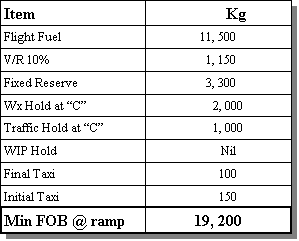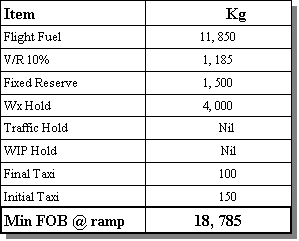|
Let us look at an example:
Example. Given:
Flight from departure airport "A" to destination airport "C". Distance
"A" to "C" 1, 000 nm.
Between airport "A" and "C" is airport "B", which the flight
will overfly. Airport "B" is on track, 300 nm form airport "A".
Airport Status:
Airport "A" ... Acceptable, becoming Suitable if Wx holding is carried to allow
for TEMPOrary deteriorations below alternate minima. Additionally, notams indicate a 20
minutes traffic holding requirement, and a 15 minute Work in Progress holding requirement
during the period of possible use.
Airport "B"... Acceptable for the period of possible use. No other holding
requirements apply.
Airport "C"... Acceptable for the period of possible use, becoming Suitable if
Wx holding fuel is carried to allow for INTERmittent deteriorations below alternate
minima. Additionally, notams indicate a 15 minute traffic holding requirement during the
period of possible use. |
|














